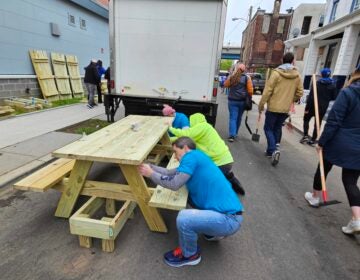The Waldorf School may relocate to Germantown
The Waldorf School of Philadelphia (WSP) says it has outgrown its space at the New Covenant campus and is working out plans to find a larger space. One site under consideration is St. Peter’s Episcopal Church in Germantown, which was built in 1873 and added to the National Register of Historic Places in 1985.
The school serves almost 200 students from nursery school age through the eighth grade.
“At this point we are bursting at the seams,” says Alexandra Borders, Director of Admissions. Space is tight in the small classrooms, particularly in the upper grades as the children grow into teenagers.
Now “at the very limits of our current space at New Covenant,” Board President Nathan Wright says that “we are looking seriously at the possibility of purchasing and renovating the site of the former St. Peter’s Episcopal Church at Wayne and Harvey to be an eventual permanent home for the school.”
The school’s steady 15-year expansion is perhaps all the more surprising in the current economic climate, one in which tuition costs can be a deal breaker, particularly for families with multiple children. Waldorf’s tuition is $11,710 for grades 1-8.
Fifteen years on, the school may be experiencing growing pains, but its mission is the same: “to integrate the intellectual with the artistic, the practical with the beautiful, and foster the ability to engage fully in the world.”
Founding the Waldorf School of Philadelphia
Nearly 20 years ago, a group of Philadelphia parents began to meet weekly to study anthroposophy, the spiritual philosophy of Rudolf Steiner, and his ideas about child development. Dissatisfied with what the public schools had to offer their children, they were drawn to the alternative pedagogy and child-centered learning approach Steiner espoused at the turn of the 20th century, a philosophy that became the basis for Waldorf/Steiner schools all over the world.
In 1992, a group calling itself the Philadelphia Waldorf Initiative was established by Boel Neville, who had been a kindergarten teacher in the closest existing Waldorf School in Kimberton, Pa. By the next year, a play group had been formed and there were a core group of parents committed to making a Philadelphia school become a reality.
Cynthia Way was one of those people. She remembers Neville as an inspiration to young families who were very interested in what she had to say about this unconventional and highly experiential approach to education. Waldorf schools are committed to hands-on learning, incorporating handwork, arts, movement, and free play into the school day.
Now teaching 2nd grade at WSP, Way got involved initially as a parent when she enrolled her son when he was three in the first class in 1996. The school moved to its current Mt. Airy location in 1998, after having outgrown the available space at St. Timothy’s in Roxborough. There was “a real pioneering spirit” about the school at the time, says Way, acknowledging that parents were taking a certain risk by putting their kids in an alternative learning environment with no track record with which to gauge the outcome.
“There were people who were really scared,” she says, “but then there were people like me who never had any doubt whatsoever.” Way was so taken by the philosophy and curriculum that when her children graduated from the WSP 8th grade, she sent them on to the Kimberton Waldorf School for high school.
Not your typical school
Waldorf schools are premised on a belief in fostering a child’s growth as a whole person, which means placing emphasis on the creative process over the rote acquisition of knowledge. “It’s not what to think, it’s how to think,” the slogan goes.
Borders with the Admission’s office sees a common thread in the parents who seek out a Waldorf education for their children. “They are searching for something beyond conventional education,” she explains. “They want their child to have beauty and wonder. . . and still be able to deftly navigate the world of killer SAT scores, coveted universities and sought after high-paying careers – even if it’s not the path they wish to follow!”
Some worry that the child-centered holistic pedagogy does not follow conventional ideas about preparation for high school or college; the Waldorf curriculum does not include tests, grades, or standardized textbooks, nor does it formally teach reading until after the first grade, and there are no computers in any of the classrooms. Students remain with the same teacher from first through eighth grade.
While unconventional in its approach, “nothing is arbitrary,” Borders explains. “We are really serious about learning, we just teach in a different way. We see that art can be an intensifier for the academics and that it makes the academics more powerfully internalized. This approach encourages curiosity, creativity and critical thinking. It’s really pretty cool to see it in action.”
To see Waldorf education in action, prospective students and their parents are invited to attend the next Open House on Saturday, October 1, which starts at 10 a.m. “Forget what you think you know about our school,” says Borders. “Come and visit, meet the parents and the teachers.”
The Open House is a unique opportunity to experience a Waldorf classroom in action, particularly for those with young children. “Each family can come into an early childhood classroom and the children can play there,” says Borders. “They can actually be dropped off with an actual kindergarten teacher while the parents attend talks on the programs.”
Children will be able to experience a day at Waldorf, complete with bread baking, free play, and a puppet play performed by teachers. “It’s kind of a fun event for the family to see if it’s a good fit for them,” Borders says. For a more formal look at WSP, she recommends scheduling a Thursday morning classroom observation, which enables parents to see the classes in action when school is in session.
“People really like to be here,” she says, and when they’re in the space, they can see first-hand “how happy our students are to be here.” In fact, she adds, “sometimes we can’t get families to leave.”
WHYY is your source for fact-based, in-depth journalism and information. As a nonprofit organization, we rely on financial support from readers like you. Please give today.




